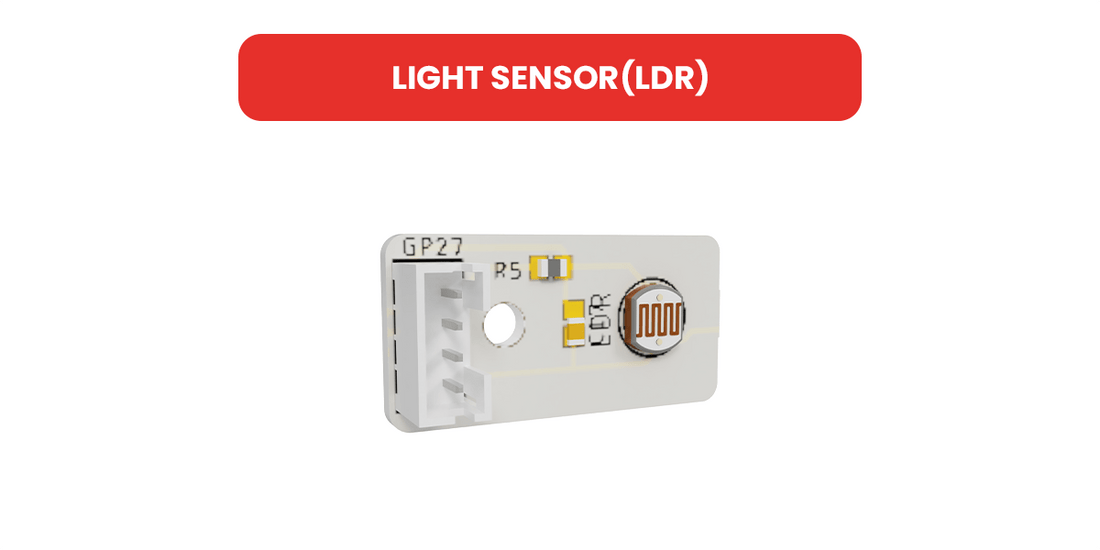Table of Contents
What Does LDR Stand for?
Light Dependent Resistor, is a type of passive electronic component that changes its resistance in response to the intensity of incident light. They are made of semiconductor materials that exhibit a decrease in resistance as the light level increases. This property makes them highly useful in various applications, such as light-sensitive switches, ambient light sensors in electronic devices, and even in photography equipment to control exposure settings. LDRs are an integral part of many circuits where the response to changing light conditions is required for automatic control or monitoring.How Does the Light Sensor Work?
A light sensor, such as an LDR (Light Dependent Resistor), works based on the principle of photoconductivity. Here's a brief explanation of how it work princieple:
-
Photoconductivity Principle: When light falls on the surface of the light sensor, it absorbs photons. This absorption leads to an increase in the energy levels of the electrons in the sensor's material.
-
Change in Resistance: In an LDR, this increase in energy allows more electrons to move freely, reducing the material's resistance to the flow of electric current. Essentially, the brighter the light, the lower the resistance.
-
Variation with Light Intensity: In dark conditions, an LDR has high resistance as fewer photons are available to energize the electrons. As the light intensity increases, more photons hit the sensor, decreasing its resistance significantly.
-
Output Signal: This change in resistance can be measured and used as a signal. For example, in a circuit, the varying resistance of the LDR can be used to control the flow of current, which can then be translated into a measurable voltage change. This voltage change is often used as an input signal for various electronic systems, such as turning lights on at dusk or adjusting the brightness of a display based on ambient light.
Here's a Project to Understand How an LDR Works
What are the Advantages of LDR?
- Simple and Low-Cost: LDRs are straightforward in design and inexpensive to manufacture.
- Sensitive to Light: They are highly sensitive to changes in light intensity.
- Easy to Use: LDRs can be easily integrated into circuits without the need for complex interfacing.
- Low Power Consumption: They consume very little power, making them suitable for battery-operated devices.
- Versatile Applications: LDRs are used in a wide range of applications, from basic light sensing to complex automatic lighting control systems.
LDR Light
LDR light refers to the illumination conditions detected by Light Dependent Resistors. They exhibit varying resistance levels in response to the intensity of incident light. In bright environments, LDRs have higher resistance, while in low-light or dark settings, their resistance decreases. This unique property allows them to act as light sensors, making them valuable components in applications like automatic lighting control, photography, and ambient light adjustment in electronic devices. These sensors are adept at translating the prevailing light conditions into electrical signals, enabling systems to adapt and respond accordingly, ensuring efficient energy use and enhancing user experiences in various scenarios.
Applications of LDRs
LDRs find applications in a wide range of devices and systems. One common use is in streetlights, where they detect the ambient light level and automatically turn on the lights when it gets dark, and turn them off when daylight returns, thereby conserving energy. In cameras, LDRs help adjust the aperture and shutter speed to achieve proper exposure. Additionally, they are employed in burglar alarm systems to trigger alerts when a sudden change in light is detected, and in outdoor weather stations for measuring light levels. LDRs play a crucial role in simplifying and automating tasks in various fields, thanks to their ability to sense and respond to changes in light intensity.

-
Street Lighting: LDRs are widely used in streetlights to detect ambient light levels. They automatically turn on the lights in the evening as darkness falls and switch them off at dawn, effectively conserving energy and ensuring safe nighttime illumination.
-
Photography: In cameras, They assist in achieving proper exposure by helping to adjust the aperture and shutter speed according to the available light conditions. This ensures that photographs are well-lit and properly exposed, regardless of the environment.
-
Security Systems: They play a crucial role in burglar alarm systems. They detect sudden changes in light, such as when a door or window is opened, and trigger alerts or alarms, enhancing security and protection.
-
Weather Stations: Outdoor weather stations utilize LDRs to measure ambient light levels. This information is valuable for meteorological data collection and analysis, helping in monitoring and predicting weather patterns.
-
Greenhouse Automation: They are employed in greenhouse automation systems to monitor natural light levels. They facilitate the regulation of artificial lighting, ensuring optimal conditions for plant growth, thereby increasing agricultural efficiency.
-
Automotive Headlights: They enable automatic switching between low and high beams in automotive headlights. They respond to changes in road lighting conditions and the presence of oncoming traffic, enhancing driver safety and convenience.
-
Electronic Displays: They are utilized in electronic displays such as digital clocks. They adjust the brightness of the display based on ambient light, improving visibility and reducing power consumption.
-
Solar Panels: In solar energy systems, They help track the sun’s movement, optimizing the positioning of solar panels for maximum energy capture. This contributes to the efficiency of solar power generation.
LDR Full Form in Electronics
An LDR sensor is a critical component in electronic devices and systems designed to detect and respond to changes in light levels. These sensors consist of a semiconductor material that exhibits a variable resistance based on the intensity of incident light. In well-lit conditions, the resistance of an LDR is relatively high, while in low-light or dark environments, its resistance decreases significantly. This unique property makes these sensors ideal for applications requiring automatic light control, such as street lighting, photography equipment, and ambient light sensing in smartphones and other electronic gadgets.
LDR sensor plays a pivotal role in simplifying our lives by providing the ability to sense and adapt to varying light conditions. They are frequently integrated into circuits and systems to ensure energy efficiency, enhance security, and improve user experiences by automatically adjusting light settings, optimizing energy consumption, and enabling responsive functionality in a wide range of electronic devices and applications.
If you want to experience the LDR Sensor on PicoBricks Simulator, you can click here!
FAQ
Is LDR a sensor or actuator?
An LDR (Light Dependent Resistor) is a sensor, not an actuator. It senses the intensity of light and changes its resistance accordingly, but it does not actuate or control any mechanical parts or systems.
Is a LDR analog or digital?
LDR (Light Dependent Resistor) is an analog device. Its resistance varies continuously with the intensity of light, allowing it to provide variable analog signals corresponding to different light levels.
What is LDR meaning?
LDR stands for Light Dependent Resistor, a sensor that changes its resistance based on the intensity of light it detects.





